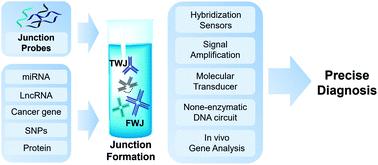当前位置:
X-MOL 学术
›
Anal. Methods
›
论文详情
Our official English website, www.x-mol.net, welcomes your
feedback! (Note: you will need to create a separate account there.)
Expanding the analytical applications of nucleic acid hybridization using junction probes
Analytical Methods ( IF 2.7 ) Pub Date : 2020-09-17 , DOI: 10.1039/d0ay01605e Xuchu Wang 1, 2, 3, 4 , Zhihua Tao 1, 2, 3, 4
Analytical Methods ( IF 2.7 ) Pub Date : 2020-09-17 , DOI: 10.1039/d0ay01605e Xuchu Wang 1, 2, 3, 4 , Zhihua Tao 1, 2, 3, 4
Affiliation

|
Nucleic acid hybridization is crucial in target recognition with respect to in vitro and in vivo nucleic acid biosensing. Conventional linear probes and molecular beacons encounter challenges in multiplexing and specific recognition of intractable nucleic acids. Advances in nucleic acid nanotechnologies have resulted in a set of novel structural probes: junction probes (JPs), which make full use of the advantages of specificity, stability, programmability and predictability of Watson–Crick base pairing. In recent years, junction probes have been regularly implemented in constructing systems related to biosensing, synthetic biology and gene regulation. Herein, we summarize the latest advances in JP designs as potential nucleic acid biosensing systems and their expansive applications, and provide some general guidelines for developing JP based sensing strategies for implementation of such systems.
中文翻译:

使用连接探针扩展核酸杂交的分析应用
核酸杂交对于体外和体内靶标识别至关重要核酸生物传感。常规的线性探针和分子信标在难处理核酸的多重化和特异性识别中遇到挑战。核酸纳米技术的进步产生了一系列新颖的结构探针:结探针(JPs),它们充分利用了Watson-Crick碱基配对的特异性,稳定性,可编程性和可预测性的优势。近年来,已在与生物传感,合成生物学和基因调控有关的构建系统中定期实施连接探针。在这里,我们总结了JP设计作为潜在的核酸生物传感系统及其广泛应用的最新进展,并提供了一些开发基于JP的传感策略以实施此类系统的一般指导。
更新日期:2020-10-12
中文翻译:

使用连接探针扩展核酸杂交的分析应用
核酸杂交对于体外和体内靶标识别至关重要核酸生物传感。常规的线性探针和分子信标在难处理核酸的多重化和特异性识别中遇到挑战。核酸纳米技术的进步产生了一系列新颖的结构探针:结探针(JPs),它们充分利用了Watson-Crick碱基配对的特异性,稳定性,可编程性和可预测性的优势。近年来,已在与生物传感,合成生物学和基因调控有关的构建系统中定期实施连接探针。在这里,我们总结了JP设计作为潜在的核酸生物传感系统及其广泛应用的最新进展,并提供了一些开发基于JP的传感策略以实施此类系统的一般指导。











































 京公网安备 11010802027423号
京公网安备 11010802027423号